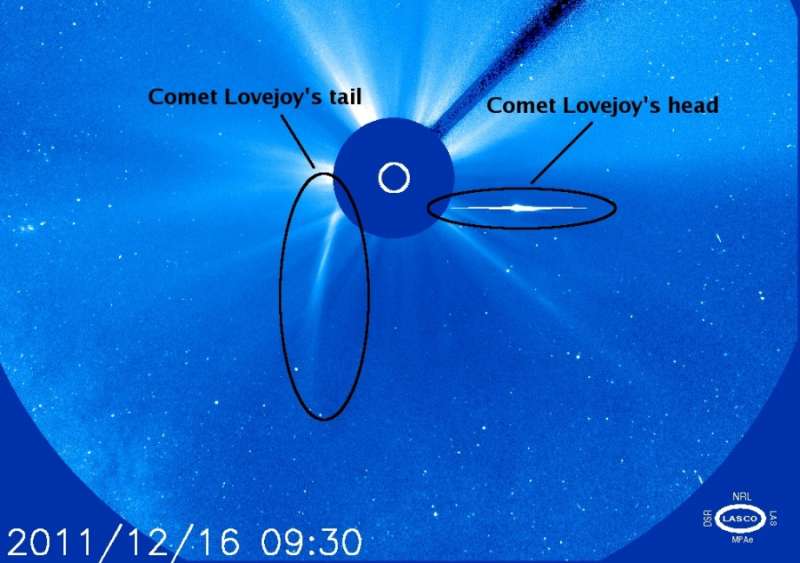
|
Explanation: Like most other sungrazing comets, Comet Lovejoy (C/2011 W3) was not expected to survive its close encounter with the Sun. But it did. This image from a coronograph onboard the sun-staring SOHO spacecraft identifies the still inbound remnants of the tail, with the brilliant head or coma emerging from the solar glare on December 16. The Sun's position, behind an occulting disk to block the overwhelming glare, is indicated by the white circle. Separated from its tail, Comet Lovejoy's coma is so bright it saturates the camera's pixels creating the horizontal streaks. Based on their orbits, sungrazer comets are thought to belong to the Kreutz family of comets, created by successive break ups from a single large parent comet that passed very near the Sun in the twelfth century. Most have been discovered with SOHO's cameras, but unlike many sungrazers, this one was first spotted by Australian astronomer Terry Lovejoy from an earth-based observatory. Comet Lovejoy is estmated to have come within 120,000 kilometers of the Sun's surface and likely had a large cometary nucleus to have survived its intense perihelion passage. Remarkable videos of the encounter from the Solar Dynamics Observatory can be found here.
|
January February March April May June July August September October November December |
| ||||||||||||||||||||||||||||||||||||||||||||||||
NASA Web Site Statements, Warnings, and Disclaimers
NASA Official: Jay Norris. Specific rights apply.
A service of: LHEA at NASA / GSFC
& Michigan Tech. U.
Based on Astronomy Picture
Of the Day
Publications with keywords: comet - sungrazer
Publications with words: comet - sungrazer
See also:
- APOD: 2025 September 30 Á Comet Lemmon Brightens
- APOD: 2025 September 29 Á Two Camera Comets in One Sky
- APOD: 2025 September 26 Á A SWAN an ATLAS and Mars
- APOD: 2025 September 18 Á Comet C/2025 R2 SWAN
- APOD: 2025 September 16 Á New Comet SWAN25B over Mexico
- APOD: 2025 July 7 Á Interstellar Comet 3I ATLAS
- Comet C/2025 F2 SWAN
